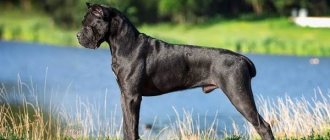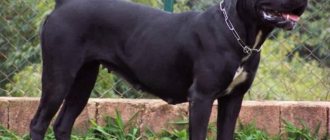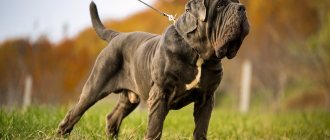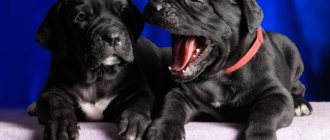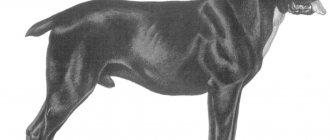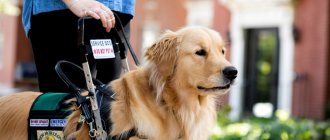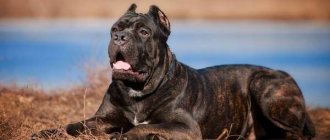The Cane Corso breed has been gaining popularity in recent years.
The dog has many advantages, it gets along well in families with children, and can become a good friend to a lonely person, but the main purpose of the breed is to protect the territory.
Cane Corsos are distinguished by their attractive appearance.
They are powerful, muscular, moderately fit, and have shiny, silky fur.
But for your dog to live with you as long as possible, it needs proper care.
How do Cane Corsos grow up?
Italian Corso Mastiffs are generally quite strong and hardy. They begin to be considered fully adults from the moment they reach 3 years of age. Dogs are considered mature after 6 years of age. The age of 8–9 years is considered very old for a Corso.
A lack of attention to alarming signals in the animal’s behavior and well-being can significantly shorten the life of a pet. Sometimes the health of females is negatively affected by too frequent pregnancies.
Important! The most common cause of health problems for both puppies and adult Cane Corsos is that unscrupulous people are involved in breeding. They cross dogs that are sick or have genetic abnormalities, mix breeds, and allow individuals who are closely related to each other to be bred for breeding.
Dog First Aid Kit
Finally, we will give some recommendations about “first aid” for your Cane Corso. Any good owner who loves and takes care of his dog should have medical supplies at the ready. To quickly bandage the paw and eliminate colic in the stomach.
Iodine, brilliant green, bandages, cotton wool, hydrogen peroxide, boric acid, and activated carbon are always welcome in a dog's first aid kit. Vishnevsky ointment is also indispensable - it quickly relieves inflammation. For pain relief and at high temperatures, the dog will need analgin.
Be sure to keep ear and eye drops on hand to treat infections. They must be special, veterinary. Among the tools, put in your first aid kit a pipette, nail clippers, a thermometer, an enema, tweezers and a couple of syringes.
Remember that even a small cut on a dog’s paw needs to be treated, and not think that it will go away on its own. And of course, give your Cane Corso maximum attention and care. It even treats animals, sometimes no worse than medicine.
Surrounded by love, your Cane Corso will undoubtedly live a long, fulfilling life!
Did you like the article? Show it off by liking it. If you have any questions, ask them in the comments or tell your story about the Cane Corso.
What can they hurt?
Most often, owners of Italian mastiffs turn to veterinarians with complaints about the following health problems in their pets:
- TC dysplasia (can appear in a dog in childhood);
- thyroid diseases;
- epileptic seizures (an illness that is inherited);
- inversion or inversion of the eyelid;
- allergic reactions;
- disorders of the gastrointestinal tract.
Important! In addition to the above-mentioned health problems, Cane Corsos can suffer from various types of viral and infectious diseases. They suffer especially hard from the consequences of tick bites.
Early mortality and its causes
With good care, the Cane Corso can live a long time even in city apartments, despite its size and character, which requires freedom. But it happens that the animal dies long before old age. There are a number of reasons why a pet may die early. These include:
- Poor nutrition. Diet is the basis of a dog's health. If feeding rules are not followed, stomach and liver diseases may develop. Lack of vitamins and microelements affects physical development and mental abilities. Large amounts of food contribute to obesity, which puts stress on the heart.
- Lack of physical activity. Corsos are active dogs that love to spend a lot of time on the move. If they are deprived of physical exercise, obesity will occur, which will lead to a number of diseases and early mortality from them.
- Sterilization and castration. There is an opinion that a sterilized animal becomes calmer and the risk of genital cancer disappears. There is also a downside. Anesthesia and surgery. Any specialist will suggest comparing the risk of surgery with the wishes of the dog owner. It’s another matter when sterilization is necessary for medical reasons.
When old age comes
As already mentioned, maturity for the Corso comes after 6 years. An aging dog begins to gradually lose ground, is less active, and its appetite may worsen. Many Corso owners note that as they approach advanced age, these dogs become more impressive, wise and noble. They phlegmatically observe those around them and in most cases remain absolutely calm.
In addition to changes in behavior, changes can also be observed in the physical condition of dogs. They appear in:
- gait disturbance;
- slow reactions;
- loss of balance;
- impaired concentration;
- heart problems;
- prostatitis ICD.
In addition to acquired diseases and congenital pathologies, with age the Corso may begin to be bothered by all previously received injuries - dislocations, fractures, sprains. If received in adulthood, they heal worse and cause more inconvenience.
How to understand that a dog is sick
The fact that there have been changes in the health and well-being of the dog for the worse will be indicated by:
- lack of appetite, refusal of water;
- dry nose not only during sleep;
- increased breathing;
- deterioration in the appearance and condition of the coat;
- blurred eyes;
- change in color of mucous membranes;
- an increase in body temperature (the norm for adults is 37.5–39, for puppies - from 38 to 39 degrees);
- lethargy;
- runny nose and discharge from the eyes;
- frequent and painful urination;
- disruption of the gastrointestinal tract;
- weight loss or, conversely, excessive weight gain.
Important! It is worth highlighting helminthiasis separately. If parasites are visible in the stool, the disease is already severe.
Story
The appearance of the breed occurs in Medieval Italy. These fearless dogs hunted wild animals, herded livestock, and were devoted guards.
But at the beginning of the 20th century, the number of these animals turned out to be minimal due to the aristocrats stopping keeping massive pets at court. Gradually, the individuals lost their purebredness - mixing of blood occurred.
In the second half of the 20th century, the history of origin took a new turn - breeders began to revive the breed and their efforts were crowned with success. In 1994, the pets received official recognition from the Italians, and then on the international stage. This allowed the roots of the corsa to be preserved.
Actions to keep your dog healthy
From the first days the puppy is in its new home, the owner must tirelessly monitor the well-being and general health of the pet. A set of measures for caring for a puppy should include:
Vaccination
The first vaccinations are given to puppies in the nursery, at the ages of 5–6, 8 and 12 weeks. After this, revaccination is carried out at 6 months and a year. All manipulations performed must be noted in the dog’s veterinary passport.
Important! Puppies that have not yet been vaccinated should not go outside.
Vaccinations are needed even for dogs that do not go beyond the boundaries of a private yard or apartment. Microbes, viruses and bacteria that are the causative agents of many deadly diseases can be brought from the street on a person’s clothes and shoes.
Important! Vaccinations are given only to completely healthy animals.
Taking Precautions
No matter how many vaccinations an adult Corso or puppy has, he still should not be allowed to have contact with stray animals and walk in landfills. Just by “talking” a little with a street dog, a domestic Corso can pick up a whole “bouquet” of diseases, the treatment of which will take a long and tedious time. And garbage dumps are usually home to rodents, whose bite can cost a dog his life.
Important! You also need to pay close attention to ensure that the dog does not pick up anything from the ground. Pieces of seemingly attractive food may contain poison, the reaction from eating which can be lightning fast.
Proper nutrition
Many experts advise feeding your Cane Corso exclusively natural, home-cooked fresh food. But this option is not always acceptable to the owner. Those who choose dry food as food for their pet should understand that a high-quality product will not be cheap.
Important! In the process of selecting a suitable “drying” for a mastiff, it is necessary to observe the behavior and general condition of the animal. If a rash appears, irritation of the mucous membranes and deterioration of digestion, the food must be changed to another.
A caring owner who wants his pet to live a long, healthy and therefore happy life should always have first aid medications with him. Your veterinarian can tell you how and what to fill the first aid kit with.
Similar articles
What determines life expectancy?
As mentioned above, many factors can affect the life expectancy of dogs of this breed. In addition to nutrition and care, the dog’s genetic fund accumulated by its ancestors plays a big role in this matter.
If your pet is healthy, then on average he will live 11, or even 14 years.
Taking care of your dog is all about proper grooming. You need to know that the period of growing up in a Cane Corso lasts up to three years, from three to six years is the period of maturity of the animal.
The pet must be vaccinated according to a certain scheme.
It is advisable to regularly undergo preventive examinations in order to identify hidden pathologies..
Year-round care is important; in winter, warm housing is selected for the dog; in summer, care should be taken to ensure that the pet is not exposed to direct sunlight. The dog has little undercoat, so in winter it freezes, and in summer it can overheat in the sun.
Mobility is also important for the Cane Corso; walks with physical activity should be regular.
And of course, the main condition for a long life of an animal is a healthy and nutritious diet.
The dog should receive all the necessary vitamins and minerals with food, but it is important not to overfeed him . Premium food is ideal for Cane Corso; it is expensive, but contains all the useful ingredients.
As a result, you will save on additional purchases of teeth cleaning equipment, meats, grains, and vitamin and mineral supplements.
Expert opinion
Kozhevin Semyon Kirillovich
Expert dog handler.
“If you want to extend the life of your dog, then you need to know complete information about this breed. The life expectancy of a Cane Corso is influenced by proper care, nutrition, and timely elimination of various diseases. It influences the condition of the dog and the genetic factor. Only armed with the necessary knowledge can you influence the life expectancy of your pet.”
Description
During selection, breeders used purebred individuals. These dogs are muscular, confident dogs. They have an attentive gaze, interesting facial expressions, and strong bones, which makes the pet look angry and aggressive.
The animal has an athletic build:
- straight strong back;
- powerful legs, shoulders;
- the docked tail is compacted at the base;
- massive head, upturned muzzle, uniform and elastic skull;
- the forehead in front is slightly convex, and the occipital part is flattened;
- the nose is black, the nostrils are large;
- moderately sagging lips, tightly closing jaws;
- large teeth;
- the iris has a black tint (occasionally there are specimens with blue eyes);
- hanging ears of a triangular shape (they can be cropped);
- dense skin, hard shiny coat.
From the description of the breed it is clear that this is an elegant dog with powerful muscles. Fans of the animal especially highlight its endurance, tireless efficiency, and protective qualities.
Breed information
This breed has been known since the Roman Empire. At that time, these dogs were used for battles in the arena and for guarding palace grounds.
At the beginning of the last century, the dog was undeservedly forgotten, but now it is again popular and in demand.
It is customary for Cane Corso dogs to have their tails and ears cropped, despite the fact that in many European countries this procedure is prohibited by law.
The dog has prominent muscles and a powerful chest. Representatives of this breed have a wide head and large paws. The length of the body is slightly greater than the height of the dog at the withers.
The coat color can be different - gray (both light and dark), black, brindle and red.
As adults, dogs can grow up to 70 cm, with an average weight of 45 to 59 kg. Bitches are always smaller in size than males.
Read more about Cane Corso sizes and standards here.
Rules for choosing puppies
It is difficult to purchase a purebred Cane Corse. You should enlist the help of an experienced dog handler.
When contacting breeders, you should pay attention to such nuances as:
- Availability of official documents with the results of checks for the absence of ongoing dysplasia in the baby’s parents.
- Was testing carried out to identify the dog’s unbalanced mental state, with a corresponding note in the certificate?
- Do the parents have a breeding assessment of the exhibition not lower than “very good”.
Puppies must be branded, ears and tail docked, and vaccinated. Healthy babies grow up calm, have an appetite, a strong psyche, and courage.
It is better to buy a pet after 5 months, when the teeth have changed, the bite has become clear, and the eye color has normalized.
Characteristics
Corso representatives are large in size. An adult dog has the following parameters:
| Male | Bitch | |
| Height at withers/cm. | 62-70 | 58-66 |
| Weight, kg. | 45-50 | 40-45 |
You can understand your pet’s compliance with breed standards by the development indicator by month:
| Age/month | Bitches | Males | ||
| Height/cm | Weight/kg | Height/cm | Weight, kg | |
| 3 | 42 | 12,5 | 49 | 13,5 |
| 4 | 47 | 16,5 | 56 | 18 |
| 5 | 55 | 22,5 | 62 | 24,5 |
| 6 | 57 | 28 | 64 | 31,5 |
| 7 | 58 | 33,5 | 65 | 37,5 |
| 8 | 59 | 36 | 65,5 | 40 |
| 9 | 59,5 | 38 | 66 | 42 |
| 10 | 60 | 40 | 66 | 44 |
| 11 | 61 | 41,5 | 67 | 45,5 |
| 12 | 63 | 43 | 67 | 47,5 |
| 24 | 64 | 45 | 68 | 50 |
This is an average characteristic to guide the owner while the dog is growing. These weight and height tables allow you to track the development of your pet at any age.
Historical reference
The Cane Corso dog breed is undeniably the heir to the ancient Molossians, to be more precise, the ancient Tibetan Great Danes. Modern Tibetan Mastiffs (Mastiffs) are a breed that has experienced “reincarnation” more than once, but their appearance even today makes people shiver with goosebumps. The first Tibetan Dogo appeared on the Eurasian mainland 1000 years BC, or so the story goes. An aggressive giant trained to catch people was presented as a gift to the ruler of China. Having spread throughout Europe and Asia, Molossians became the ancestors of many modern breeds.
New breeds of dogs have been developed over the centuries to suit the needs of specific territories. The descendants of the Molossians who came to the Roman Empire were also used for their intended purpose - arena battles, military campaigns, and territory protection. Mentions of giants called Corso are found in hunting and baiting chronicles dating back to 1400–1500. It should be noted that in some territories, four-legged animals were used as flock guards. Chroniclers characterize the ancient Cane Corsos as strong, tireless, fearless and loyal dogs.
It is ethical to count the official history of the breed from the times of the prosperity of the Roman Empire. It is this time period that is replete with historical monuments depicting the early Cane Corso in hunting, arenas and fighting. The development of these powerful dogs is continuously intertwined with the history of Italy. Even without delving into cynology references, historical sources tell of giant dogs dressed in armor and lined up in ranks. About dog fights and fights with wild animals. About evil four-legged slave overseers and palace guards.
The Roman Empire fell shortly before the fifth hundred years of our era and a feudal system reigned in Italy. This stage should be considered as a separate step in the formation of the breed. The export of dogs atypical for Italy, for example, Celtic Greyhounds, led to changes and the creation of new progenitors of the breed. Against the backdrop of changes, the already established Italian Cane Corso was widespread throughout the country, especially in the South, where hunting for large wild animals flourished.
With the new regime, dogs began to be used in a new position - guarding farms in the off-season. After the harvest, the land was left under the responsibility of one person and several Cane Corsos. It should be noted that the breed was used for quite a long time as a cattle driver, which also limited contact with the outside world. The echoes of such “professions” were unshakable loyalty to one person - the owner.
The versatile use of Molossians has led to the versatility of modern Cane Corsos. In addition, such powerful dogs were highly valued, which led to a global expansion of the high-quality gene pool. However, history cannot be a straight line; there are always peaks and valleys. The downfall of the breed was the Second World War, the general crisis and the collapse of the economies of many countries. Lack of food and the extermination of “non-front” dogs brought the Cane Corso to the point of extinction and the end of these giants was too close to prevent it.
The revival of the ancient giants is an example of the titanic loyalty and perseverance of one man - Mr. Giovanni Bonatti Nizzoli. Being an educated person, versed in history and facts, the man believed in a miracle and raised the wave of the revival of the Cane Corso. 10 years after the idea was conceived, in 1983, a group of researchers (who were also the founders of the Cane Corso lovers club) literally combed the southern regions of Italy in search of surviving representatives of the breed. By 1987, the first official breed standard was drawn up. The description not only revealed in detail every feature of the ancient giants, but also clearly indicated the differences between the Cane Corso and Mastiffs and Neapolitan Mastiffs in particular.
Before the official opening of breeding registration (1994), more than 500 producers and 700 puppies received positive expert assessment and recognition. Immediately after the recognition of the breed by the Italian Canine Society, the number of dogs exceeded the three thousandth threshold. In 1996, the best producer of Italy with honor defended the reputation of the Cane Corso at the FCI (International Cynological Association) exhibition.

